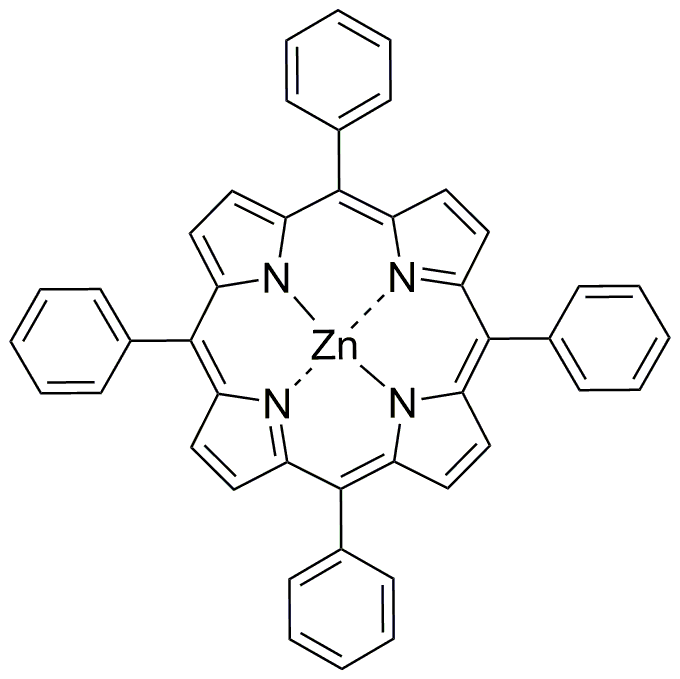Zinc(II) Tetraphenylporphyrin is widely utilized in research focused on:
- Photodynamic Therapy: This compound is used in medical applications to treat certain cancers. Its ability to generate reactive oxygen species upon light activation makes it effective in targeting and destroying cancer cells.
- Solar Energy Conversion: In the field of renewable energy, it serves as a photosensitizer in dye-sensitized solar cells, enhancing the efficiency of light absorption and energy conversion.
- Catalysis: It acts as a catalyst in various chemical reactions, particularly in organic synthesis, improving reaction rates and selectivity compared to traditional catalysts.
- Sensor Development: This compound is employed in the creation of chemical sensors for detecting gases and pollutants, providing a sensitive and selective response to environmental changes.
- Biochemical Research: Researchers use it to study electron transfer processes in biological systems, contributing to a better understanding of metabolic pathways and energy transfer in cells.
Información general
Propiedades
Seguridad y normativas
Aplicaciones
Zinc(II) Tetraphenylporphyrin is widely utilized in research focused on:
- Photodynamic Therapy: This compound is used in medical applications to treat certain cancers. Its ability to generate reactive oxygen species upon light activation makes it effective in targeting and destroying cancer cells.
- Solar Energy Conversion: In the field of renewable energy, it serves as a photosensitizer in dye-sensitized solar cells, enhancing the efficiency of light absorption and energy conversion.
- Catalysis: It acts as a catalyst in various chemical reactions, particularly in organic synthesis, improving reaction rates and selectivity compared to traditional catalysts.
- Sensor Development: This compound is employed in the creation of chemical sensors for detecting gases and pollutants, providing a sensitive and selective response to environmental changes.
- Biochemical Research: Researchers use it to study electron transfer processes in biological systems, contributing to a better understanding of metabolic pathways and energy transfer in cells.
Documentos
Hojas de datos de seguridad (HDS)
La SDS proporciona información de seguridad completa sobre la manipulación, el almacenamiento y la eliminación del producto.
Especificación del producto (PS)
La PS proporciona un desglose completo de las propiedades del producto, incluida la composición química, el estado físico, la pureza y los requisitos de almacenamiento. También detalla los rangos de calidad aceptables y las aplicaciones previstas del producto.
Certificados de análisis (COA)
Busque certificados de análisis (COA) ingresando el número de lote del producto. Los números de lote y de partida se pueden encontrar en la etiqueta de un producto después de las palabras "Lote" o "Lote".
Número de catálogo
Número de lote/lote
Certificados de origen (COO)
Este certificado de origen confirma el país en el que se fabricó el producto y también detalla los materiales y componentes utilizados en él y si se deriva de fuentes naturales, sintéticas u otras fuentes específicas. Este certificado puede ser necesario para cumplir con las normativas aduaneras, comerciales y regulatorias.
Número de catálogo
Número de lote/lote
Hojas de datos de seguridad (HDS)
La SDS proporciona información de seguridad completa sobre la manipulación, el almacenamiento y la eliminación del producto.
DownloadEspecificación del producto (PS)
La PS proporciona un desglose completo de las propiedades del producto, incluida la composición química, el estado físico, la pureza y los requisitos de almacenamiento. También detalla los rangos de calidad aceptables y las aplicaciones previstas del producto.
DownloadCertificados de análisis (COA)
Busque certificados de análisis (COA) ingresando el número de lote del producto. Los números de lote y de partida se pueden encontrar en la etiqueta de un producto después de las palabras "Lote" o "Lote".
Número de catálogo
Número de lote/lote
Certificados de origen (COO)
Este certificado de origen confirma el país en el que se fabricó el producto y también detalla los materiales y componentes utilizados en él y si se deriva de fuentes naturales, sintéticas u otras fuentes específicas. Este certificado puede ser necesario para cumplir con las normativas aduaneras, comerciales y regulatorias.


